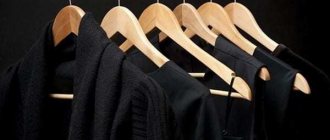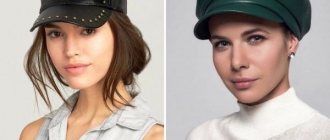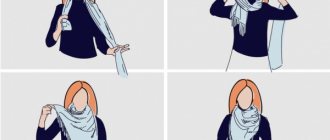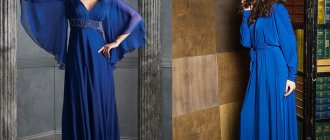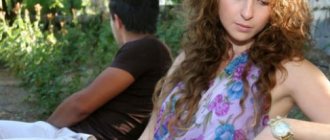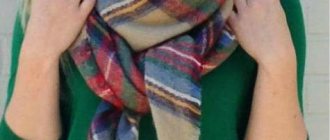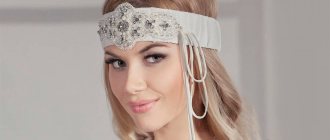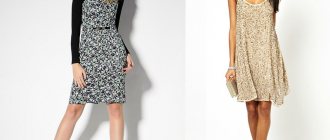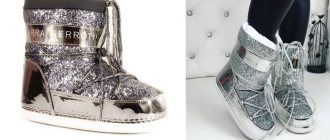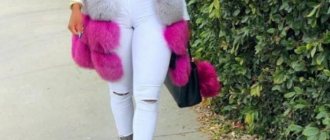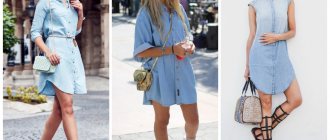By the beginning of the third decade of the 21st century, the appearance of a special forces soldier in almost any country in the world includes a keffiyeh in protective colors. It is also worn by soldiers of the “simpler” branches of the military, as well as militants with mercenaries of all stripes.
The universal love of the military for Arafat women is not accidental. Scarves made of loose cotton fabric are good in any weather. In hot weather, the keffiyeh protects from the sun, is ventilated and absorbs sweat. It's cold - it works like a scarf. You can tie it on your face, hiding it from unnecessary glances or from dust.
The “auxiliary functions” of the shemagh are very extensive. Someone is injured and doesn’t have a full first aid kit at hand? Here is a dressing or material for fixing the damaged limb. The keffiyeh can be rolled up and used as a short rope, or you can put things in it and roll it into a bundle.
The keffiyeh is also suitable for partially filtering water that is too dirty and full of turbidity - and as a towel. With its help, you can take a hot kettle - or spread it out like a tablecloth at a rest stop. It can even become a weapon: just roll the scarf into a sling and find a suitable stone, or use it as a noose.
Grigory Pastushkov Field expert in reserve
The main function has been forgotten - you can take amazingly tactical photographs in an arafatka. A dunce with a Kalashmat will surprise no one. A dunce with a Kalashmat in dark glasses and an arafat is another matter. An arafatka, pulled over the face, will cover up acne, swelling after yesterday's excesses, general unsightliness - and convey mystery and threatening mystery to the wearer. God created people beautiful and not very beautiful, brutal-looking and homely-looking. Arafat equalized them, just as Colonel Colt and Sergeant Kalashnikov erased the line between the strong and the weak.
Well, in peacetime, the arafat can be seen on fashionistas of all views and tastes - from bohemian hipsters on the Berkeley campus to neo-Nazis in east Berlin.
And only Palestinian activists have been grimly swearing for the second decade about cultural expropriation and the “possession” of their primordial national symbol. You can sympathize with them, but the train left long ago. Keffiyeh has become an element of the global dress code and is not going to lose ground.
It’s clear why everyone loves keffiyeh. But why exactly did she become so popular? After all, from time immemorial, scarves have been worn by almost all peoples of the planet.
A little bit of history
The direct purpose of the keffiyeh in countries with a hot and dry climate is protection from overheating, wind, and sand. The way of tying the keffiyeh is different in different countries. For example, in Saudi Arabia it is customary to tie this accessory by simply throwing it over the head without creating knots; for support, a special headband is used on top of a scarf, and in Oman this scarf is tied on the head in the form of a kind of turban with complex fastening techniques.
During the Israeli-Palestinian conflict, television often broadcast news with speeches by Palestinian leader Yasiyar Arafat, wearing a traditional keffiyeh. In honor of Arafat, this item of clothing was named colloquially among the Russian-speaking population - Arafatka.
Modern arafatkas
Every person wants to follow fashion trends, look stylish, modern, special. Currently, the Arabic arafatka scarf is relevant as an additional accessory to any look around the world. It is worn by both men and women.
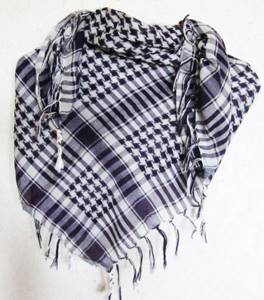
Arabic scarves for lovely ladies are made in accordance with the season. Accordingly, for the warm season, fabrics of this type are made from thin material - cotton or synthetics, and for the cold season - from dense fabric with the addition of wool, which has a warming effect.
https://youtu.be/https://youtu.be/MjQtYxi95b4
_
How to tie an arafat around your neck?
- Fold the arafatka on the chest into a triangle. Cross the ends behind your back so that the left one is on the right shoulder, and the right one is on the left. Tuck the ends under a scarf at the front. You can tie them, pulling the arafat to your neck.
- Fold the scarf diagonally and twist it into a rope. Then wrap it around your neck twice, tying the ends with two knots.
- Tie loosely on the chest in knots, like a pioneer tie.
We looked at the most famous options for tying an arafatka. In fact, human imagination is limitless
. So, no matter how you tie your Arabic scarf, it will be correct.
19584
Reading time ≈ 5 minutes
The Arabic arafatka scarf is one of the many types of scarf. What is its main feature? In the recognizable checkered pattern, unusual fringe braids or the oriental charm that any outfit acquires, all you have to do is tie this accessory around your neck? A fashionable arafat scarf in 2020 will be a good purchase and will be useful for fashionistas both in the cool season and on a hot, sultry day.
Let's find out how to use this stylish and trendy item. You can learn how to tie it on the head and neck from this material. In the meantime, we invite you to look at numerous photos of fashionable Arafatka scarves for women for 2020:
How do arafatkas differ from traditional Russian scarves?
Firstly, Russian scarves for everyday use were made in a single color, and for special occasions or going out they were decorated with ornaments of flowers, curls and other intricate figures. Arafats can also come in a wide range of colors, but most often in an easily recognizable checkered pattern, sometimes with stripes. At the moment, there is no strict distinction in decorating arafatkas; they can contain elements of various geometric designs.
Secondly, the framing of scarves is mainly a fringe of threads of raw edges, and Arab representatives of this item of clothing are woven into peculiar braids.
Description
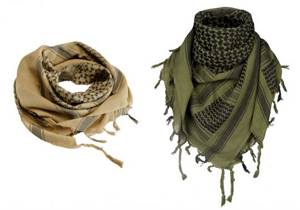
The men's arafatka is a wide scarf (sizes 1x1m, 1x1.10m, 1x1.25m), used as protection in hot countries (UAE, Egypt and others) from the scorching rays of the sun, sand, and high temperatures. In addition to practical use by residents of Arab countries and the military, the keffiyeh is also offered as a stylish detail of a man’s image. It is easy to distinguish arafatka from other hats.
- Initially, it was worn on the head like a turban by Bedouins traveling through the deserts. Then British soldiers in the colonial era, seeing the practical value of the accessory, made the “Palestinian” an integral part of the military uniform and called it “shemagh”.
- In Arab countries, this is an integral part of any man’s everyday wardrobe. And the rest of the world uses the arafatka in military affairs (and not only as protection for the head and neck) or as a fashionable addition to the image.
- Initially, the colors were only light and monochromatic (white more often). In the Gulf countries this option is still preferred. Then checkered patterns and different colors appeared.
- Only natural fabric is preferred: cotton or wool. But recently they have begun to make keffiyehs with the addition of synthetic materials, which make it possible to keep the headdress wrinkle-free and more wearable for a long time.
Note: Arab sheikhs do not change traditions today. They wear keffiyehs made exclusively of cotton, sometimes with the addition of wool.
Shades: pink, purple, crimson, checkered black and white, black and red, yellow and black, olive with black and brown patterns in military affairs. The main thing is a motley pattern and thin fabric that protects against overheating and hypothermia to the same extent.
Fashion trends from the East
Anything unusual that stands out from the crowd always becomes fashionable. At the moment, women's arafatkas are a common item in the wardrobe of a modern lady. The uniqueness of this accessory lies in the way it is tied, that is, having several arafatkas in stock, you can change it every day. Moreover, they can be worn as a headdress, scarf or bandage on any part of the body. You can also experiment with ways to design the look of tying knots, use ready-made proposals from fashion magazines, blogs, etc., or invent your own.
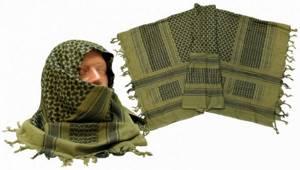
As a headdress, an Arabic scarf of this type is usually used in cool weather to preserve heat, and in warm weather to escape the heat. This accessory will harmoniously complement and decorate any look. Arafats are relevant for the wardrobe of both an adult, accomplished woman and a very young girl. These scarves attract the attention of others and indicate the owner’s good taste and sense of style.
For the wardrobe of the stronger half of humanity, men's arafatkas of various colors are made. Most often, men use this item of clothing in the form of a bandage around their neck, emphasizing their individuality and creating a fashionable style.
Arafatka men's military
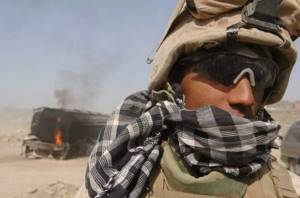
The main role of the men's military arafat jacket is functionality and practicality. In the army, it helps protect the face and neck from heat, dust and sand, and the head and shoulders from overheating when serving in hot countries.
But also olive and brown colors can make the keffiyeh on a soldier’s face almost invisible: the scarf in the form of a mask will blend into the uniform and hide the face from the enemy.
If you are wounded, you can twist a support tourniquet for your arm from arafatka. And in extreme conditions, a scarf can serve as a foot wrap.
How to tie an arafatka
In principle, there are no strict distinctions when tying this item of clothing. Everyone wears the arafat the way they want. Some use other people's techniques, some create their own.
- 1. The simplest and most widely used way of wearing arafatka around the neck. You need to take the canvas, bend it in half to form the well-known geometric figure - a triangle. The corner of the triangle is thrown forward, the ends cross at the back and return to the front. Next, the arafatka is tied with a simple knot, a bow, or any other method of preference. There is no desire to look for easy ways, do you need complex experiments? Then you can try to place the corner of the arafatka triangle in a different order, for example, on its side and tie it with a knot in the form of the number 8. It will turn out unusual, creative and attractive. Basically, this item of clothing is worn over a coat, jacket or other clothing. Perfectly complements, serves as a decorative element and updates any familiar piece of outerwear. This simple method allows you to change every day, experiment with your look, and keep up with fashion trends.
- Often this item of clothing is also worn as a headdress. How such a headband will look depends entirely on the preference and taste of the owner of this accessory. For example, bend the fabric into a triangle and place it on your head so that the corner hangs down your back. Twist the ends to give volume and the appearance of a tourniquet, wrap it around the back of the head, tie the ends in the temple area so that the arafatka is held tightly. Hide the protruding ends under the resulting plait or give them a decorative look using an exclusive knot.
- Another popular option is to wear this scarf, twisting it like a turban. You can twist a tight turban, or a looser one and release one end of the scarf so that it falls over your shoulder. But these options are more likely for Eastern countries; in Russia they will cause surprise and a smile, rather than understanding.
Women also love to wear arafatkas
The fairer sex can wear arofat in all the ways that have been invented for scarves, scarves and shawls. That is, ladies have an almost limitless field for imagination. The most popular option is to simply roll the arafat into a scarf and throw it over your coat. This method will look especially interesting with a stand-up collar.
Another simple and beautiful way to wear this stylish accessory is to fold it in half, throw it over your head and throw one end over your shoulder. That is, as is commonly believed, women in the Caucasus wear headscarves. In fact, this is more of a festive option, since you can’t do much work in a scarf that stays on “on your word of honor” and tends to slip onto your shoulders.
There are a huge variety of ways to tie and wear arafatka. The most important thing here is to find the technique that you like. You can use classic methods without the use of imagination and creative ideas, or constantly experiment and come up with new techniques. And who knows, maybe a simple invention will become a national property, the idea will reach the very peak of popularity?
How and with what to wear arafatka in 2020
Keffiyeh in summer is a great way to protect yourself from the scorching rays of the sun. Use the scarf as a Panama hat to protect your shoulders, back or décolleté. In 2020, Arafat will fit perfectly into ethnic style and eco-style, as well as boho style. How and with what to wear this original accessory? Wear a plaid scarf with long layered skirts, simple tops, and sundresses. If you love safari style, a shemagh can become your favorite accessory; wear it with shorts, shirts, jackets. The military style also accepts a checkered scarf, if you opt not for a dress overcoat, but for camouflage pants and a racer T-shirt. The keffiyeh is also suitable for denim clothing, as well as leather trousers. How to wear an arafat in the fall and winter of 2020: the checkered accessory will perfectly complement the look with a laconic coat or short coat; it can be worn as a scarf with a parka jacket or a down jacket in muted shades. Wear the keffiyeh with leather jackets, as well as leather biker jackets or jeans.
Most often, shemagas are made in black and white; black and red checkered patterns are often found, but today you can find on sale a wide variety of variations of colored arafatkas that will suit any of your clothes.
https://youtu.be/https://youtu.be/jErQxmGC-zA
_
